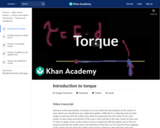
An introduction to torque. Created by Sal Khan.
- Subject:
- Physical Science
- Physics
- Material Type:
- Lesson
- Provider:
- Khan Academy
- Provider Set:
- Khan Academy
- Author:
- Sal Khan
- Date Added:
- 07/02/2021
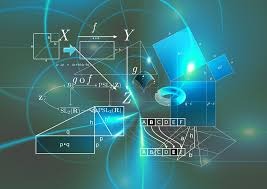

An introduction to torque. Created by Sal Khan.

Introduction to transverse and longitudinal waves. Created by Sal Khan.
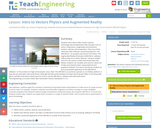
Students learn about video motion capture technology, becoming familiar with concepts such as vector components, magnitudes and directions, position, velocity, and acceleration. They use a (free) classroom data collection and processing tool—the ARK Mirror—to visualize and record 3-D motion. The Augmented Reality Kinematics (ARK) Mirror software collects data via a motion detector. Using an Orbbec Astra Pro 3D camera or Microsoft Kinect (see note below), students can visualize and record a robust set of data and interpret them using statistical and graphical methods. This lesson introduces students to just one possible application of the ARK Mirror software—in the context of a high school physics class. Note: The ARK Mirror is ported to operate on an Orbbec platform. It may also be used with a Microsoft Kinect, although that Microsoft hardware has been discontinued. Refer to the Using ARK Mirror and Microsoft Kinect attachment for how to use the ARK MIrror software with Microsoft Kinect.
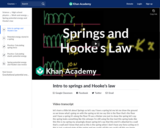
Introduction to Hooke's Law. Created by Sal Khan.
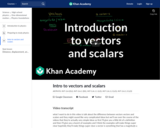
The difference between vectors and scalars. Introduction to distance, displacement, speed, and velocity. Created by Sal Khan.

David defines what it means for something to be a simple harmonic oscillator and gives some intuition about why oscillators do what they do as well as where the speed, acceleration, and force will be largest and smallest. Created by David SantoPietro.
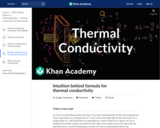
Intuition behind formula for thermal conductivity.
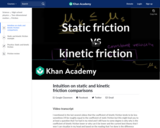
Why static friction is harder to overcome than kinetic friction. Created by Sal Khan.
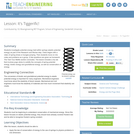
Students investigate potential energy held within springs (elastic potential energy) as part of the Research and Revise step. Class begins with a video of spring shoes or bungee jumping. Then students move on into notes and problems as a group. A few questions are given as homework. The Test Your Mettle section concludes. The lesson includes a dry lab that involves pogo sticks to solidify the concepts of spring potential energy, kinetic energy and gravitational energy, as well as conservation of energy.
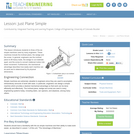
This lesson introduces students to three of the six simple machines used by many engineers. These machines include the inclined plane, the wedge and the screw. In general, engineers use the inclined plane to lift heavy loads, the wedge to cut materials apart, and the screw to convert rotational motion into linear movement. Furthermore, the mechanical advantage describes how easily each machine can do work and is determined by its physical dimensions.

Students learn how roadways are designed and constructed, and discuss the advantages and limitations of the current roadway construction process. They look at current practices of roadway monitoring, discuss the limitations, and consider ways to further road monitoring research. To conclude, student groups compete to design smooth, cost-efficient and sound model road bases using gravel, sand, water and rubber (representing asphalt). This lesson prepares students for the associated activity in which they act as civil engineers hired by USDOT to research through their own model experimentation how to best use piezoelectric materials to detect road damage by showing how piezoelectric transducers can indicate road damage.
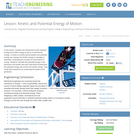
In this lesson, students are introduced to both potential energy and kinetic energy as forms of mechanical energy. A hands-on activity demonstrates how potential energy can change into kinetic energy by swinging a pendulum, illustrating the concept of conservation of energy. Students calculate the potential energy of the pendulum and predict how fast it will travel knowing that the potential energy will convert into kinetic energy. They verify their predictions by measuring the speed of the pendulum.
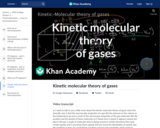
In this video David explains how the internal energy of a gas varies as a function of temperature. Created by David SantoPietro.
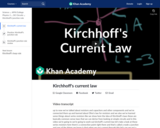
Kirchhoff's Current Law says the currents flowing into a node must add up to zero. Created by Willy McAllister.
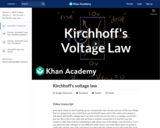
Kirchhoff's Voltage Law says if you travel around any loop in a circuit, the voltages across the elements add up to zero. Created by Willy McAllister.
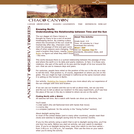
This activity shows how our experience of the Sun changes with time and location. The sun dagger at Chaco Canyon is thought by many to be a sort of ancient timekeeping device. By creating a place where the movement of the Sun could be tracked day after day, Chacoans could mark the passage of time and gain an idea of when seasons were changing. If the Chacoans could use a particular location and the Sun to tell them about time, can we use time and the Sun to tell us about our location? In this easy experiment, you'll see how the position of the Sun in the sky is related to where we are on the earth.

David shows how LOL diagrams allow us to visually represent what we mean by conservation of energy as well as what we mean by an energy system. Created by David SantoPietro.
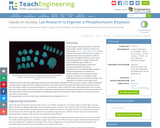
Students gain first-hand experience with the steps of the scientific method as well as the overarching engineering design process as they conduct lab research with the aim to create a bioplastic with certain properties. Students learn about the light mechanism that causes ultraviolet bead color change, observe the effect of different light waves on a phosphorescence powder, and see the connection between florescence, phosphorescence and wavelength. Students compose hypotheses and determine experimental procedure details, as teams engineer variations on a bioplastic solid embedded with phosphorescence powder. The objective is to make a structurally sound bioplastic without reducing its glowing properties from the powder embedded within its matrix. Groups conduct qualitative and quantitative analyses of their engineered plastics, then recap and communicate their experiment conclusions in the form of a poster, slides and verbal presentation. As an extension, teams make their own testing apparatuses. As a further extension, they combine all the group results to determine which bioplastic matrix best achieves the desired properties and then “manufacture” the optimum bioplastic into glowing toy figurine end products! Many handouts, instructions, photos and rubrics are provided.
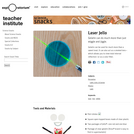
In this activity, learners use gelatin as a lens to investigate the properties of laser light. Learners can view total internal reflection of a beam of light and investigate angles of reflection and refraction. Using different colors of gelatin demonstrates its color filtering properties. Use this activity to help learners explore light reflection and refraction, wavelengths, color, and lenses.

In this activity, learners use a laser pointer and two small rotating mirrors to create a variety of fascinating patterns, which can be easily and dramatically projected on a wall or screen. In this version of the activity, learners use binder clips to build the base of the device. Educators can use a pre-assembled device for demonstration purposes or engage learners in the building process.